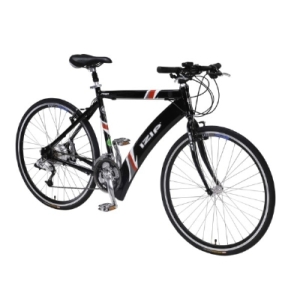 Rather than all this impersonal planning for the future, I thought I’d take a step back and look at some of the things we’ve already been doing. One of the things I’ve enjoyed most has been taking my daughter to Kindy on the bike. This came about as a result of a number of things hitting us at once.
Rather than all this impersonal planning for the future, I thought I’d take a step back and look at some of the things we’ve already been doing. One of the things I’ve enjoyed most has been taking my daughter to Kindy on the bike. This came about as a result of a number of things hitting us at once.
My daughter’s first Kindy was just around the corner from my work, a job where I had a free, reserved parking space. We’d drop my wife at work, I’d drop my daughter at Kindy and then park at work – nice and easy, but not a fantastically efficient use of a 2.5 litre engine attached to a couple of tonnes of 4×4. However, just as my wife was starting maternity leave for our number two, the Kindy announced that it was closing. This was quite a blow, and after a hurried search we got her a spot at a brand new Kindy just a kilometre or so further away. But it was a kilometre further into the City, so rather than drving across all the rush-hour traffic I’d now be stewing in it with everybody else. In addition, our office had just moved and I had no free parking space – parking would now cost me $10/day.
So all our car-sharing travel plans were thrown up in the air. To top it all, it made a lot of sense for my ready-to-burst wife to have access to the car during the day. To our credit, we never thought about just buying a second car (partly we’re green, partly we’re just very economical). And as I couldn’t face the excruciatingly tedious extra commute we had to find other options. None of our buses went anywhere near the new Kindy – we’d have had to change at least once. Luckily I’m still just about able to get on a bike, and my little one loves zooming around in her bike trailer.
However to get to Kindy we’d need to cross some of Brisbane’s busiest roads, and I wasn’t confident enough to be doing that with the trailer. Another solution was needed – a normal bike seat. That’s when I found the WeeRide. It’s significantly more expensive that a normal rear-mounted seat – ours cost us $180 – but I found that a conventional rear mounted seat wouldn’t fit my mountain bike, so our options were limited.
It has been worth every penny cent. This picture was taken in April, and we’ve ridden into kindy twice a week, every week since, with only about 7-8 missed trips due to holiday or torrential tropical storms! That’s been a direct saving of around $500 in parking – not counting the wear and tear, extra petrol, or possible second car we might have needed otherwise. We haven’t quite got rid of our SUV – but we’ve certainly taken one vehicle out of Brisbane’s busy morning commute.
And . . we have a great time. With her on the front we spend the whole trip chatting, counting, learning colours, and generally experiencing the world together – it is just a delight. Enough to make me ignore the fact that the kindy is at the top of a hill!
